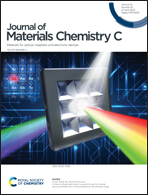Investigation on energy resolution of CsPbBr3 detectors: from charge transport behavior to device configuration†
Abstract
All-inorganic perovskite CsPbBr3 serving as an ionizing radiation material exhibits tremendous potential in many fields. However, its applications are limited by poor energy resolution (ER), which is significantly associated with both material properties and device configurations. In this work, the effects of applied electric field, crystal thickness and carrier transport properties on the ER of CsPbBr3 detectors are investigated by theoretical simulation. For the first time, the (μτ)e/(μτ)h ratio as a critical factor that affects the ER has been revealed, which provides guidance on electrode configuration design for enhancing charge collection efficiency and minimizing the tailing in pulse height spectra. Additionally, experimental investigations on electrode structures of CsPbBr3 detectors have been conducted. The resulting ER of CsPbBr3 detectors is improved from 30.3% (planar electrode) to 11.76% (quasi-hemispherical electrode) at 59.5 keV γ-rays. Furthermore, the quasi-hemispherical detector also achieves an ER of 11.47% at 137Cs 662 keV γ-rays, showing great potential for high-energy γ-ray detection. These experimental results are in good accordance with the simulation calculations, demonstrating that both crystallization improvement and optimization of the device configuration can enhance the ER of radiation detectors.



 Please wait while we load your content...
Please wait while we load your content...